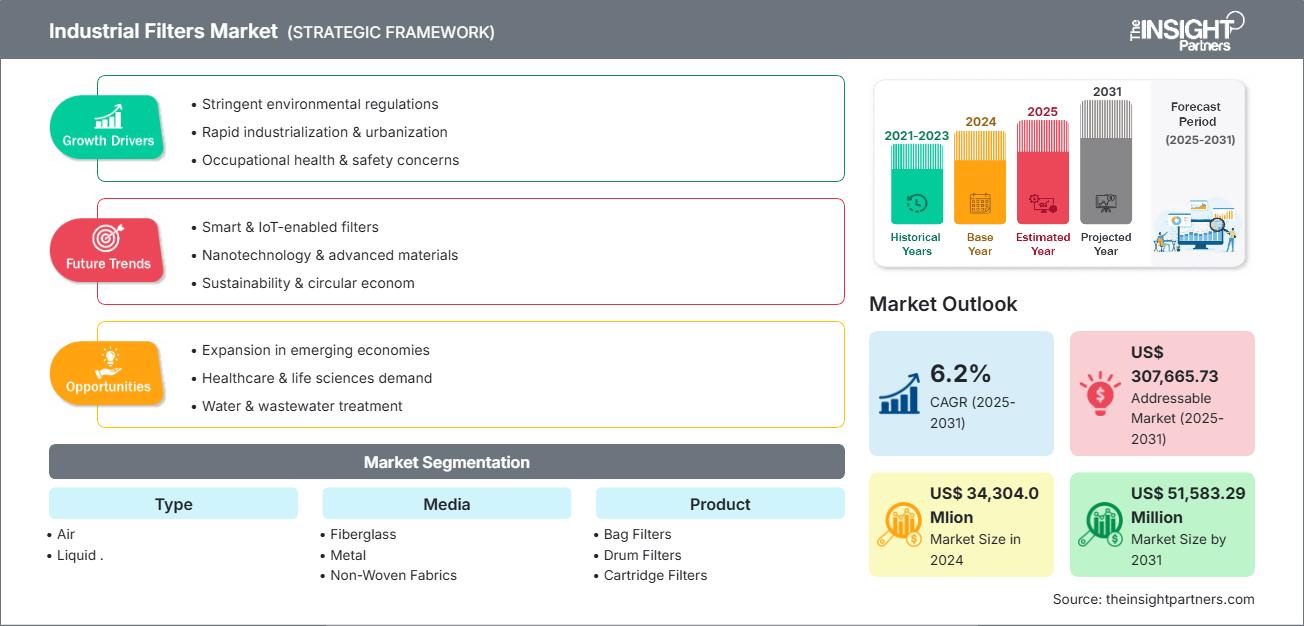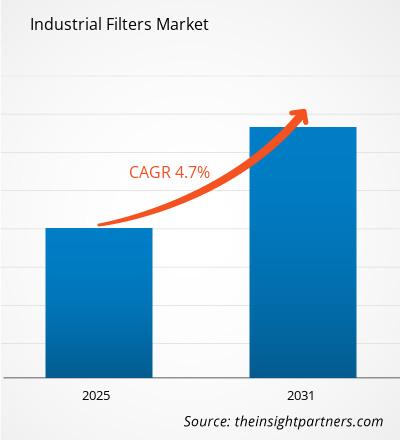Der Markt für Industriefilter wird voraussichtlich im Jahr 2024 38,25 Milliarden US-Dollar und bis 2031 52,36 Milliarden US-Dollar erreichen; von 2025 bis 2031 wird eine durchschnittliche jährliche Wachstumsrate (CAGR) von 4,9 % erwartet.
Der Bericht zum Markt für Industriefilter ist nach Produkttyp in die folgenden Untersegmente unterteilt: Flüssigkeitsfilter, Luftfilter und Sonstige. Er ist auch nach Endverbraucher segmentiert, darunter Lebensmittel und Getränke, Metall und Bergbau, Chemie, Pharmazie, Energieerzeugung und Sonstige. Die globale Analyse ist auf regionaler Ebene und nach den wichtigsten Ländern aufgeschlüsselt. Die Marktbewertung wird für die obige Segmentanalyse in US-Dollar angegeben, mit Prognosen bis 2031.
Zweck des Berichts
Der Bericht „Markt für Industriefilter“ von The Insight Partners zielt darauf ab, die aktuelle Situation und das zukünftige Wachstum sowie die wichtigsten treibenden Faktoren, Herausforderungen und Chancen zu beschreiben. Dies bietet verschiedenen Geschäftspartnern Einblicke, wie beispielsweise:
- Technologieanbieter/-hersteller: Um die sich entwickelnde Marktdynamik zu verstehen und die potenziellen Wachstumschancen zu kennen, damit sie fundierte strategische Entscheidungen treffen können.
- Investoren: Um eine umfassende Trendanalyse hinsichtlich der Marktwachstumsrate, der finanziellen Marktprognosen und der Chancen entlang der Wertschöpfungskette durchzuführen.
- Regulierungsbehörden: Um Richtlinien und Überwachungsaktivitäten auf dem Markt zu regulieren, mit dem Ziel, Missbrauch zu minimieren, das Vertrauen der Investoren zu wahren und die Integrität und Stabilität des Marktes aufrechtzuerhalten.
Marktsegmentierungstyp für Industriefilter
- Flüssigkeitsfilter
- Luftfilter
Endbenutzer
- Lebensmittel und Getränke
- Metall und Bergbau
- Chemie
- Pharma
- Energie Generation
- Andere
Sie erhalten kostenlos Anpassungen an jedem Bericht, einschließlich Teilen dieses Berichts oder einer Analyse auf Länderebene, eines Excel-Datenpakets sowie tolle Angebote und Rabatte für Start-ups und Universitäten.
Markt für Industriefilter: Strategische Einblicke

- Holen Sie sich die wichtigsten Markttrends aus diesem Bericht.Dieses KOSTENLOSE Beispiel umfasst Datenanalysen, die von Markttrends bis hin zu Schätzungen und Prognosen reichen.
Wachstumstreiber für Industriefilter
- Verbesserung der Gesetze zur industriellen Umweltverschmutzung: Strenge Umweltgesetze in den Bereichen Luft- und Wasserverschmutzung zwingen die Industrie, in effektive Filtertechnologien zu investieren.
- Industrialisierung und Wachstum im verarbeitenden Gewerbe: Das Wachstum im verarbeitenden Gewerbe und in der Industrie in Schwellenländern führt zu einer steigenden Nachfrage nach Filterlösungen, da die Luft- und Wasserqualität aufrechterhalten werden muss.
- Technologische Fortschritte bei der Filtereffizienz: Innovationen bei neuen Materialien und Filterdesigns verbessern die Effizienz und Lebensdauer industrieller Filter und sorgen so für Kosteneffizienz.
Zukünftige Trends im Markt für Industriefilter
- Filtersysteme für Robotik und Automatisierung: Die Integration von IoT und KI ermöglicht die Überwachung und Steuerung von Filtersystemen in Echtzeit und ist somit Teil des sich entwickelnden Trends, da sie die Effizienz des Systems steigert und das Risiko von Zeitverlusten verringert.
- Nutzung umweltfreundlicher Filter: Mit der Mit dem zunehmenden Umweltbewusstsein besteht ein Trend zur Verwendung umweltfreundlicher und biologisch abbaubarer Materialien zur Herstellung von Filtern, wodurch Abfallprodukte reduziert und die Nachhaltigkeit gewahrt werden.
- Angewandte Hightech-Filtertechniken: Nanofaserfilter und Elektrofilter werden zunehmend in der Industrie eingesetzt, die strenge Luftqualitätsstandards einhält.
Marktchancen für Industriefilter
- Wachstum in den Bereichen saubere Energie und Abwasserbehandlung: Da die Branchen für saubere Energie und Abwasserbehandlung wachsen, wird die Nachfrage nach Industriefiltern steigen, um eine bessere Luft- und Wasserqualität in diesen Branchen zu gewährleisten.
- Anpassung an Nischenanwendungen: In Nischenanwendungen wie der Pharma-, Lebensmittel- und Getränkeindustrie sowie der Petrochemie bieten sich Möglichkeiten durch maßgeschneiderte Filterlösungen.
- Industriefilter: Intelligente Filter mit IoT-Integration bieten eine gute Gelegenheit. Die Entwicklung von Industriefiltern basiert auf IoT-Funktionen, die Echtzeit Überwachung und ermöglicht vorausschauende Wartung.
Markt für Industriefilter
Die Analysten von The Insight Partners haben die regionalen Trends und Faktoren, die den Markt für Industriefilter im Prognosezeitraum beeinflussen, ausführlich erläutert. In diesem Abschnitt werden auch die Marktsegmente und die geografische Lage in Nordamerika, Europa, dem asiatisch-pazifischen Raum, dem Nahen Osten und Afrika sowie Süd- und Mittelamerika erörtert.Umfang des Marktberichts über Industriefilter
| Berichtsattribut | Einzelheiten |
|---|---|
| Marktgröße in 2024 | US$ 34,304.0 Mlion |
| Marktgröße nach 2031 | US$ 51,583.29 Million |
| Globale CAGR (2025 - 2031) | 6.2% |
| Historische Daten | 2021-2023 |
| Prognosezeitraum | 2025-2031 |
| Abgedeckte Segmente |
By Typ
|
| Abgedeckte Regionen und Länder | Nordamerika
|
| Marktführer und wichtige Unternehmensprofile |
|
Dichte der Marktteilnehmer für Industriefilter: Verständnis ihrer Auswirkungen auf die Geschäftsdynamik
Der Markt für Industriefilter wächst rasant. Die steigende Nachfrage der Endverbraucher ist auf Faktoren wie veränderte Verbraucherpräferenzen, technologische Fortschritte und ein stärkeres Bewusstsein für die Produktvorteile zurückzuführen. Mit der steigenden Nachfrage erweitern Unternehmen ihr Angebot, entwickeln Innovationen, um den Bedürfnissen der Verbraucher gerecht zu werden, und nutzen neue Trends, was das Marktwachstum weiter ankurbelt.

- Holen Sie sich die Markt für Industriefilter Übersicht der wichtigsten Akteure
Wichtige Verkaufsargumente
- Umfassende Abdeckung: Der Bericht analysiert umfassend Produkte, Dienstleistungen, Typen und Endnutzer des Marktes für Industriefilter und bietet einen ganzheitlichen Überblick.
- Expertenanalyse: Der Bericht basiert auf dem umfassenden Verständnis von Branchenexperten und Analysten.
- Aktuelle Informationen: Der Bericht gewährleistet Geschäftsrelevanz durch die Berichterstattung über aktuelle Informationen und Datentrends.
- Anpassungsoptionen: Dieser Bericht kann an spezifische Kundenanforderungen angepasst werden und passt sich den Geschäftsstrategien optimal an.
Der Forschungsbericht zum Markt für Industriefilter kann daher dazu beitragen, die Branchensituation und die Wachstumsaussichten zu entschlüsseln und zu verstehen. Obwohl es einige berechtigte Bedenken geben kann, überwiegen die Vorteile dieses Berichts tendenziell die Nachteile.
- Historische Analyse (2 Jahre), Basisjahr, Prognose (7 Jahre) mit CAGR
- PEST- und SWOT-Analyse
- Marktgröße Wert/Volumen – Global, Regional, Land
- Branchen- und Wettbewerbslandschaft
- Excel-Datensatz
Aktuelle Berichte
Erfahrungsberichte
Grund zum Kauf
- Fundierte Entscheidungsfindung
- Marktdynamik verstehen
- Wettbewerbsanalyse
- Kundeneinblicke
- Marktprognosen
- Risikominimierung
- Strategische Planung
- Investitionsbegründung
- Identifizierung neuer Märkte
- Verbesserung von Marketingstrategien
- Steigerung der Betriebseffizienz
- Anpassung an regulatorische Trends






















 Kostenlose Probe anfordern für - Markt für Industriefilter
Kostenlose Probe anfordern für - Markt für Industriefilter